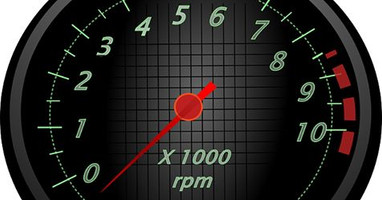Why are Wide Open Throttle RPM So Important?
Posted by Chris on Feb 21st 2017
Why are Wide Open Throttle (WOT) RPM so important? As I have mentioned in a previous blog post, what WOT RPM you are getting along with your current propeller size and pitch are the most important numbers for us to determine which props you can and should be running on your boat. Every engine has a WOT RPM operating range that is specified by the manufacturer. Not being within this range can not only affect performance, but damage the motor as well.
We carry an inexpensive tachometer here.
Many people will ask, “I never run my engine at full throttle, so why do I need to know what my WOT RPM is?” To answer that question, we will be looking at a section from Quicksilver’s publication, Everything You Need to Know About Propellers. This guide was put out by Brunswick, Quicksilver’s parent company in 1992.
“An engine that does not reach the rated RPM at wide-open-throttle is an “over-propped” condition, resulting in “lugging.” This high-torque operation puts a tremendous load on the pistons, crankshaft, and bearings. The engine runs much hotter and may overheat from having over-advanced spark timing for the reduced amount of fuel entering the engine. The mechanical strain on an over-propped marine engine is like starting an automobile in third gear from a dead stop at the bottom of a hill. This severe strain can lead to detonation, piston seizure, and engine damage.
On the other hand, an engine that revs past the recommended RPM will have higher than normal wear and can also be damaged by fatigued parts breaking and passing through the engine.
This is why it is so critical to be sure your engine is propped correctly for your boat/engine combination and the type of boating you want to do.”
I would like to add that what your engine does at WOT tells us what it will do at other throttle locations. In other words, if you are lugging at the top end, you will be lugging in the middle and at the low end.
You may be saying to yourself, “That’s good to know, but what does that information do for me?” The answer is that once you know what RPM you are getting at WOT, you have a pretty good idea as to which changes you need to make to get into your recommended RPM range. Every inch of pitch equals about 200 RPM with RPM and pitch having an inverse relationship. When you go UP an inch of pitch, your RPM should DECREASE by around 200. When you go DOWN an inch of pitch, your RPM should INCREASE around 200 RPM. Also, as you increase pitch, you should increase speed, but lose low end or hole shot. Basically, the higher the pitch the faster you go (as long as you remain in the engine’s powerband) and the longer it takes to get on plane. I have provided links to charts put out by Solas that show recommended WOT RPM for many engines. These charts are only a rough guide and you should consult your engine manual for more clarification.
Click here to access Michigan Wheel's Manufacturer Recommended WOT RPM Chart
**This blog entry is basic information and does not get into the performance and RPM changes of cupping, adding more blades, etc. For more information, feel free to send us an EMAIL or give us a call at 800-634-8318**

